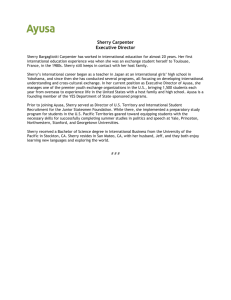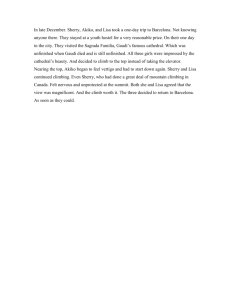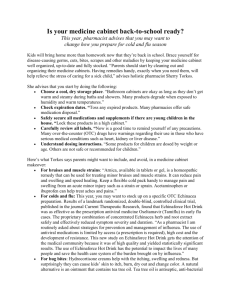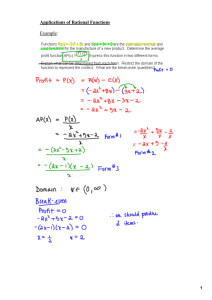- The bft The Big Fortified Tasting
advertisement
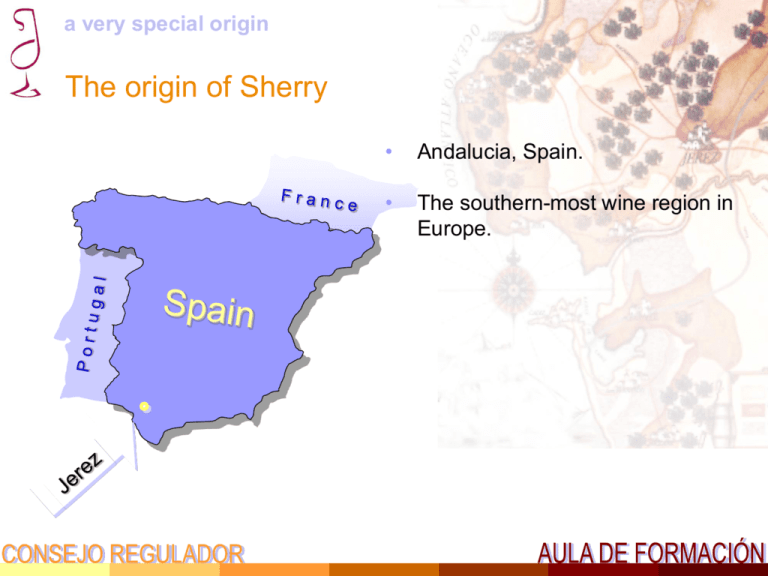
a very special origin The origin of Sherry • Andalucia, Spain. • The southern-most wine region in Europe. a very special origin The origin of Sherry wines • Sanlúcar Demarcated area – the “Sherry Triangle”: - Jerez de la Frontera Jerez - El Puerto de Santa María - Sanlúcar de Barrameda El Puerto • 10.500 hectares of vineyard protected by the “Denomination of Origin”. 3,000 years of history Same town,different names, from Xera to Jerez de la Frontera 10 BC 5 BC 2 BC Tartessos Phoenicians Greeks Carthagineans Roman Empire 0 Goths 5 AD Africa 8 AD Arabic domination 13 AD Christian “reconquista” Discovery of America 15 AD 3.000 years of history Early XIXth C. – Sherry as we know it Abolition of the Vintners Guild. Use of fortification as an oenological tool. Need of a consistent quality – birth of the “Solera system” The Denominations of Origin Three different D.O.´s... ...with one single origin. • JEREZ-XÉRÈS-SHERRY • MANZANILLA – SANLÚCAR DE BARRAMEDA • VINAGRE DE JEREZ 3,000 years of history The key role of foreign traders • • • Numerous traders (mainly British) established themselves in the region Association with local shippers and growers. Increasing pressure to liberalise the trade. In the U.K. • • Become a firm favourite over the Centuries, mentioned by Shakespeare, Dickens, etc. Poet Laureate’s rewarded with it! a very special origin Main climatic factors • Very high levels of sunlight (300 days of sunshine per annum). • Mild winters (4º C) and very extreme summers (40º C). • Average rainfall of approx. 620 litres per square metre. • Key influence of the predominant winds: Levante (east) and Poniente (west). Sherry viticulture The “albariza” soil. • Very chalky (high content in clacium carbonate). • High level of porosity – helps keeping the humidity. • White colour (“alba”). Other types of soil: - arenas (coastal areas) - barros (valleys) Sherry viticulture Authorised grape varieties. palomino pedro ximénez moscatel Sherry wine-making The Harvest • Early ripening of the grapes - September. • 11 to 12,5º baumé. • 90% hand-picked. Need of rapid harvesting Sherry wine-making Producing Sherry is a matter of... nature tradition technology The first steps – wine-making: Pressing of the grapes Classification of the musts Fermentation Base wine Sherry wine-making The base wine • End of november - the “deslío”. • Dry white wine. • 11º to 12,5º alcohol. • Spontaneous development of the “flor” on the surface of the wine. flor vino en claro lees Sherry wine-making Flor – the key to Sherry wines • Veil of natural (local) yeasts – different strains of Saccharomices Ellipsoideous. • Protects the wine from oxidation. • Permanent interaction with the wine. • Requires precise living conditions: temperature humidity aeration... … and alcoholic content. Sherry wine-making The fortification Sensorial classification • Pale and light wines: • Heavier, darker wines: fino oloroso / O fortification = addition of pure wine distillate objective: increase the wine´s alcoholic strength / Fino fortified up to 15º O Oloroso fortified up to 17º Sherry wine-making The different levels of alcohol will determine the future ageing of sherry inside the casks at 15º alc. The wine keeps the flor at 17º alc. The wine looses the flor Biological ageing Oxidative ageing The flor protects the wine from oxidation Without the flor, the wine is exposed to oxidation Sherry wine-making The “crianza” – the ageing of Sherry • Use of oak “botas” (butts) of American Oak. • Three years minimum ageing in wood. • Genuine ageing method of “criaderas y solera”. American oak barrels 600 litres capacity Only filled up to 500 litres Sherry winemaking The system of “ciaderas y solera” • A “dynamic” method of ageing wines. • Based on fractional blending of different vintages. • Different ageing systems for every style of wine. • Guarantees a consistent quality and personality for the wines, year after year. Sherry wine-making How does the solera work? andana Year wine 2nd. criadera “rocíos” 1st. criadera solera “saca” Sherry winemaking The making of Sherry – the key ideas Base wines: it all starts with a white wine with something unique - the flor. Fortification level determines biological or oxidative ageing. Special containers (botas) in special buildings (bodegas). Minimum ageing period of three years. The solera: a never-ending ageing system. If you want to learn more... read this: “Sherry, the Noble Wine” by Manuel M. González Gordon “Sherry”, by Julian Jeffs “Sherry and the Sherry Bodegas”, by Jan Read The diversity of Sherry wines sweetness Two key factors determine Sherry´s enormous diversity manzanilla fino dry amontillado oloroso The level of oxidation medium The level of sweetness dark pale Determined by the type pale cream of ageing Determined by the cream sugars residual sweet oxidation moscatel pedro ximénez The diversity of Sherry wines The dimension TIME in Wood. 30 + 20 + 12 & 15 6 + 3 + enjoying sherry Sherry and food Apart from being an ideal aperitif, Sherry is also the perfect companion for many dishes. • This is the way it is drunk in Spain with Tapas. • A different, diverse and powerful taste. • Great alternative for matching with some foods. Often the only one. • Ingredient and companion at the same time. enjoying sherry Sherry and food Some examples... Fino / Manzanilla all kinds of “tapas”, seafood, white fish and mild cheese. Amontillado soups and consommes, white meat, blue fish and cured cheese. Oloroso poultry, game and red meat; tuna. Medium (slightly chilled) patés and quiches. Pale Cream (cold) foie-gras and fresh fruit. Cream desserts (also a great aperitif served on ice!). Pedro Ximénez deserts, ice creams and blue cheese. The diversity of Sherry wines Dry styles of Sherry FINO MANZANILLA OLOROSO AMONTILLADO PALO CORTADO BIOLOGICAL AGEING…………………...……….OXIDATIVE AGEING The diversity of Sherry wines Manzanilla fina • Very pale, straw yellow colour. • Pungent, yeasty nose with hints of almonds and camomile. • Dry, fresh, delicate and nicely bitter in the palate, with salty notes. • Very light overall impression. Alcohol content between 15 and 17% vol. Less than 1 gram of sugar per litre Total acidity (tartaric) <3,5 grams / litre Volatile acidity (acetic) <0,2 grams / litre Very low level of glycerine The diversity of Sherry wines Fino • Aged exclusively through biological ageing (evolution under flor). • Pale, straw yellow colour. • Pungent nose, with hints of yeasts (fresh dough) and dry fruits (almonds). • Dry, light, delicate taste. Alcohol content between 15 and 17% vol. Less than 1 gram of sugar per litre Total acidity (tartaric) <3,5 grams / litre Volatile acidity (acetic) <0,2 grams / litre Very low level of glycerine The diversity of Sherry wines Amontillado • Partially aged with flor: both biological and oxidative ageing. • Amber to pale mahogany colour. • Slightly pungent, with a deep, complex, nutty nose. • Light and smooth, round in the palate, with a long after-taste. Alcoholic content between 16 and 22% vol.. Less than 5 grms. of sugar per litre Total acidity (tartaric) <5 grams / litre Volatile acidity (acetic) <0,8 grams / litro The diversity of Sherry wines Oloroso • Exclusively oxidative ageing. • Intense mahogany colour, darker as the wine gets older. • Very deep aromas (oloroso). Warm, round and complex. • Smooth and full bodied. Glyceric and with a very long after-taste. Alcohol content between 17 and 22% vol. Less than 5 grms. of sugar per litre Total acidity (tartaric) <5 grams / litre Volatile acidity (acetic) <0,8 grams / litre The diversity of Sherry wines Palo cortado • An exceptional, very rare wine, produced through long oxidative ageing of very fine wines. • Bright mahogany colour. • Encompasses the delicate, slightly pungent nose of amontillados with the structure and depth of olorosos. • Shows a characteristic lactic note. Alcohol content between 17 and 22% vol. Less than 5 grams of sugar per litre Total acidity (tartaric) <5 grams / litre Volatile acidity (acetic) <0.8 grams / litre The diversity of Sherry wines Natural Sweet Wines • Use of specific grape varieties: Pedro Ximénez & Moscatel. • Extra maturation of grapes through sundrying of the grapes (“soleo”). • Partial fermentation of the grape must. The diversity of Sherry wines Cream • Dark mahogany colour. Dense appearance. • Intense aroma of oloroso, combined with notes of raisined grapes. • Full bodied, sweet and velvety in the palate. Alcohol content between 15,5 and 22% vol. More than 115 grms. of sugar per litre Total acidity (tartaric) <3,5 grams / litre Volatile acidity (acético) <0,6 grams / litre The diversity of Sherry wines Palo cortado • An exceptional, very rare wine, produced through long oxidative ageing of very fine wines. • Bright mahogany colour. • Encompasses the delicate, slightly pungent nose of amontillados with the structure and depth of olorosos. • Shows a characteristic lactic note. Alcohol content between 17 and 22% vol. Less than 5 grams of sugar per litre Total acidity (tartaric) <5 grams / litre Volatile acidity (acetic) <0.8 grams / litre The diversity of Sherry wines Natural Sweet Wines • Use of specific grape varieties: Pedro Ximénez & Moscatel. • Extra maturation of grapes through sundrying of the grapes (“soleo”). • Partial fermentation of the grape must. The diversity of Sherry wines Cream • Dark mahogany colour. Dense appearance. • Intense aroma of oloroso, combined with notes of raisined grapes. • Full bodied, sweet and velvety in the palate. Alcohol content between 15,5 and 22% vol. More than 115 grms. of sugar per litre Total acidity (tartaric) <3,5 grams / litre Volatile acidity (acético) <0,6 grams / litre The diversity of Sherry wines Pale Cream • Pale, straw yellow colour. • Notes of almonds and of biological ageing. Slightly pungent. • Sweet, light and fresh in the palate. Alcohol content < 15,5% vol. More than 100 grms. of sugar per litre Total acidity (tartaric) <3,5 grams / litre Volatile acidity (acético) <0,2 grams / litre The diversity of Sherry wines Pedro Ximénez • Extremely dark mahogany colour and dense, syrupy appearance. • Deep aromas of dried fruits (raisins), gaining complexity with ageing: toffee, licorize... • Very sweet taste, with a smooth, velvety texture. Very long after-taste. Alcoholic content between 15 and 22% vol. Between 400 and 500 grms. of sugar per litre Total acidity (tartaric) 4-5 grams / litre Volatile acidity (acetic) +0,4 grams / litre enjoying sherry Remember... Sherry is a Wine To enjoy at its best, it should be consumed within a reasonable period after purchase. Try and buy Fino and Manzanilla from outlets with good turnover for freshness. type of Sherry sealed bottle open bottle • fino / manzanilla 12 to 18 months one week (*) • amontillado / medium 18 to 36 months 2 - 3 weeks • oloroso / cream 24 to 36 months 4 - 6 weeks • pedro ximénez 24 to 48 months 1 - 2 months (*) kept in the fridge, properly closed. enjoying sherry How should I store the bottles? As for any other quality wine, find a quiet place, with stable temperature, safe from strong light and vibrations. • Keep the bottles standing up, so that the surface in contact with the air inside the bottle is reduced to a minimum. • Once unsealed, keep the bottles properly closed, and if there is not much wine left in the bottle... ...find a good excuse to finish it! enjoying sherry What kind of glasses for Sherry? The traditional “catavino” or “copita” is the ideal glass for drinking Sherry. • However, any good quality wine glass with the proper bowl (in order to allow the “breathing” of the wine) and stem (to avoid warming up) would allow us to enjoy Sherry. Drink and treat as you would a white wine. enjoying sherry Serving temperatures Except for fino and manzanilla (always well chilled) there are no strict rules for serving Sherry. recommended temperatures • Fino & Manzanilla – always very cold, between 7 and 9 º C. • Pale Cream at approximately 10º C. • Medium, lightly chilled, at about 10 - 11º C. • Cream is best enjoyed at approximately 13º C, although it is also delicious as an aperitif “on the rocks”. • dry Amontillado and dry Oloroso, between 13 and 14º C. • Pedro Ximénez, at approximately 15º C. enjoying sherry Enjoying Sherry – the key ideas Sherry is a wine – and should be used as such... Fino & Manzanilla ALWAYS chilled. An amazing wine for food. Versatility – a key strength of Sherry. If you want to learn more... read this: “Cooking with Sherry” by Lalo Grosso de MacPherson Enjoy Sherry SOON & OFTEN!

